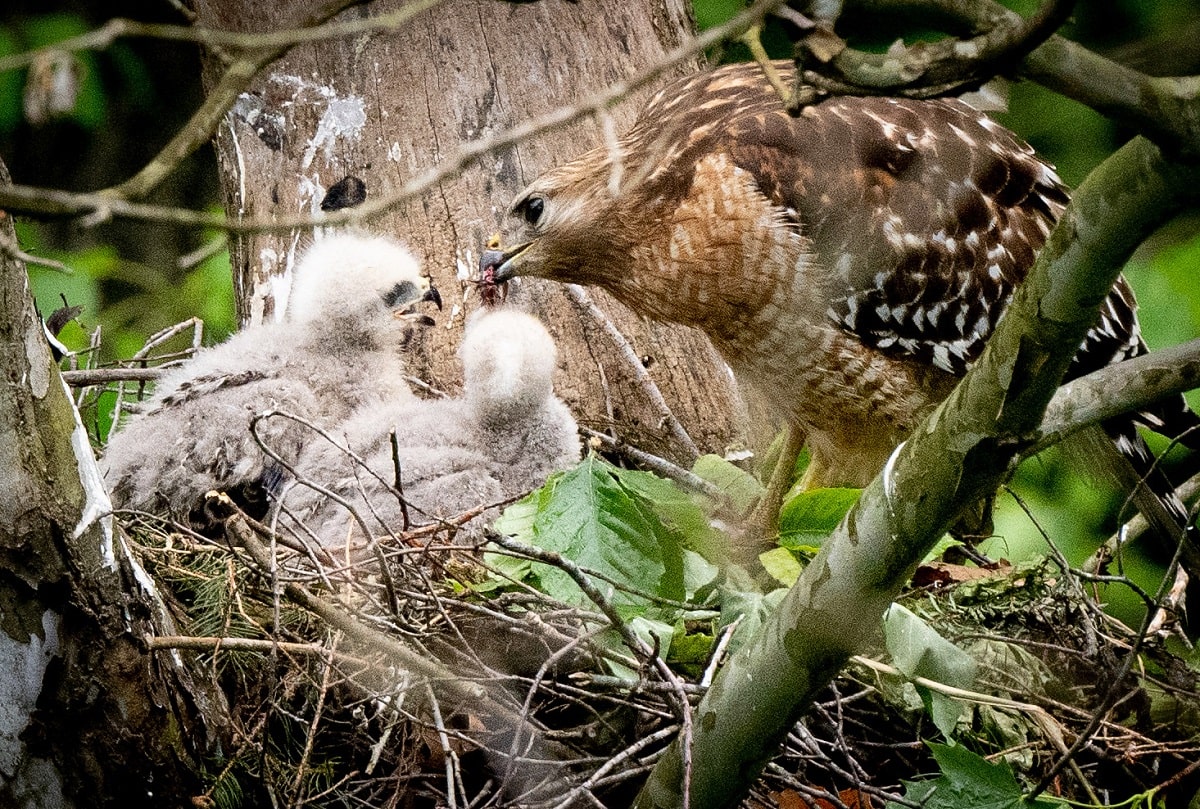Red-shouldered Hawk: The Complete Guide to Their Behaviors
When in flight, Red-shouldered Hawks may resemble Accipiter's such as the Cooper's Hawk, with their quick wingbeats followed by short glides.
But once you've spotted and especially when you've learned their call, you won't mistake them for any other than what they are, Buteo lineatus. (scientific name)
Identification: Size, Field Marks
A medium-sized bird of prey, larger than the Broad-winged Hawk and smaller than the Red-tailed Hawk. Adults have brownish heads and backs, rufous shoulder patches, and black and white flight feathers.
The breast and belly are colored with pale orange or reddish horizontal barring. The image below is from my own backyard. A nesting pair has been around for 3 years now.

Their long tails are black with three distinct thin white bands. Juveniles are mostly brown with cream-colored underparts and brown streaking, especially on their chests.
Their wingspan can be as much as 3 1/2 feet. The main difference between males and females is that the female is larger.
If you spot them soaring overhead, especially against the light, you'll notice translucent, crescent-shaped patches near the tips of their wings.
It's interesting to note that their may be slight variations in appearance across their range, and there are five recognized subspecies.
Red-shouldered Hawk Bird in Flight Call
Eleven seconds of the common flight call. Blue jays imitate the hawks sound very well while flying toward bird feeders.
Mating Habits
These birds are quite vocal, especially during the breeding season which begins in mid-March to early April.
Their typical call is a loud Kee-aah scream, which is often mimicked by Blue Jays to scare other birds away from feeders.
Most individuals start breeding when they are two years old. About 5 percent of females will breed as yearlings.
Pairs usually stay on the same breeding grounds and feeding territories reusing the same nest sites for many years.
Territories for these birds can range anywhere from 200 to just over 400 acres.
Courtship Behavior
During courtship, they engage in circling flights and sky-dancing displays.
Circling courtship flights involve soaring together with wings spread and tails fanned out. Males also perform sky-dances, repeatedly diving steeply and then soaring upward in a spiral.
You'll have a difficult time not hearing these birds as they are particularly vocal during courtship displays.
Breeding Season
The Red-shouldered Hawk's main breeding season runs from mid-March thourgh April.
Although at southern latitudes, breeding can begin as early as January and more northern locations can be as late as May
.Do They Mate For Life?
While Red-shouldered Hawks are monogamous it's more about territory than fidelity.
Pairs may stay in the same territory and re-mate in subsequent years but no studies show mating for life.
Diet Hunting Habits
While many hawks hunt food by soaring over the ground Red-shoulder's have a unique hunting habit that sets them apart.
They often perch and patiently observe their surroundings, whether it's within a forest or in open areas. From their vantage point, they keep a keen eye out for potential prey.
When they spot a target such as small birds below the bird feeders, they swiftly swoop down, taking their prey by surprise.
It's worth noting that these hawks may also rely on their exceptional hearing to locate their next meal, in addition to their sharp eyesight.
When it comes to feeding habits, they are generalists and eat various types of prey. Their diet includes amphibians, reptiles, birds, and mammals.
In the southeastern United States, crayfish are an important food source. In much of eastern North America, Eastern Chipmunks (John W. Portnoy and Wendell E. Dodge) and Meadow Voles are their main prey.
Adults usually bring back mammals to feed the nestlings. While they sometimes hunt on the wing, mostly they hunt from perches.
My own observations were mice and snakes making up most of the nestlings diet.
Nesting: Building, Eggs, Incubation, Fledging
The nest site of the Red-shouldered Hawk is typically built in deciduous or mixed deciduous-coniferous forests.
The nests are usually located close to the main trunk of the tree. They prefer to be high up in the tree but still under the main canopy of leaves and branches for safety.

Nests can be placed 36 to 60 feet above ground. These hawks prefer the tallest tree in wooded areas.
Both male and female Hawks participate in nest construction, which takes about one to five weeks.
The stick nest is around 18 - 24 inches in diameter and 8 - 12 inches deep, made from sticks, bark strips, dried leaves, lichens, conifer sprigs, and Spanish moss.
The female lays one clutch of eggs per year, clutch size is typically three to four eggs. Sometimes only two eggs are laid.
If the first clutch is destroyed, they may attempt a second nesting. Nest success varies depending on factors like the timing of nesting and food availability.
The eggs have a pale bluish-white color, speckled with brown or lavender dark marks of color.
The incubation period of the eggs is about five weeks, incubation is done mainly by the female.
Asynchronous hatching occurs because eggs are laid 2 - 3 days apart and incubation begins before all the eggs are laid.
| Red-shouldered Hawk Nesting Stats | |
|---|---|
| Eggs | 2 - 4 |
| Incubation | 33 days each egg |
| Nestling Phase | 35 - 45 days |
| Broods | 1 |
After the eggs hatch, the female continuously broods the nestlings for about a week, gradually spending less time brooding.
She will continue to roost on the nest for 3 to 4 weeks after the brooding ends.
The male is responsible for providing food while the female remains at the nest.
He brings food near the nest and calls for the female, who accepts the prey and delivers it to the young.
As the nestlings grow, both parents hunt for food. The young start tearing apart food at around 18 days old.
The nestling stage lasts between 35 and 45 days at which time the young will leave the nest.
Eight to ten weeks after the young leave the nest, these juvenile hawks begin catching prey on their own, starting with insects and moving on to small rodents.
Migration
Migration patterns vary across their range. In the eastern part of North America, individuals from the northern half of their range migrate, while most populations in the West are permanent residents.

These hawks are considered short to moderate-distance migrants, traveling between 180 and 900 miles each way.
They follow leading lines, migrating along inland ridges and coastlines.
During migration, immature birds usually precede adults in the autumn, while adults lead the way in the spring.
Red-shouldered Hawk typically migrate alone, but sometimes form small flocks. They tend to avoid crossing large bodies of water.
Some of these hawks spend the winter in the southeastern United States, although some travel as far south as central Mexico.
Predators
Predation is also a threat, with Great Horned Owls, raccoons, Red-tailed Hawks, Peregrine Falcons, martens, and fishers being potential predators.






